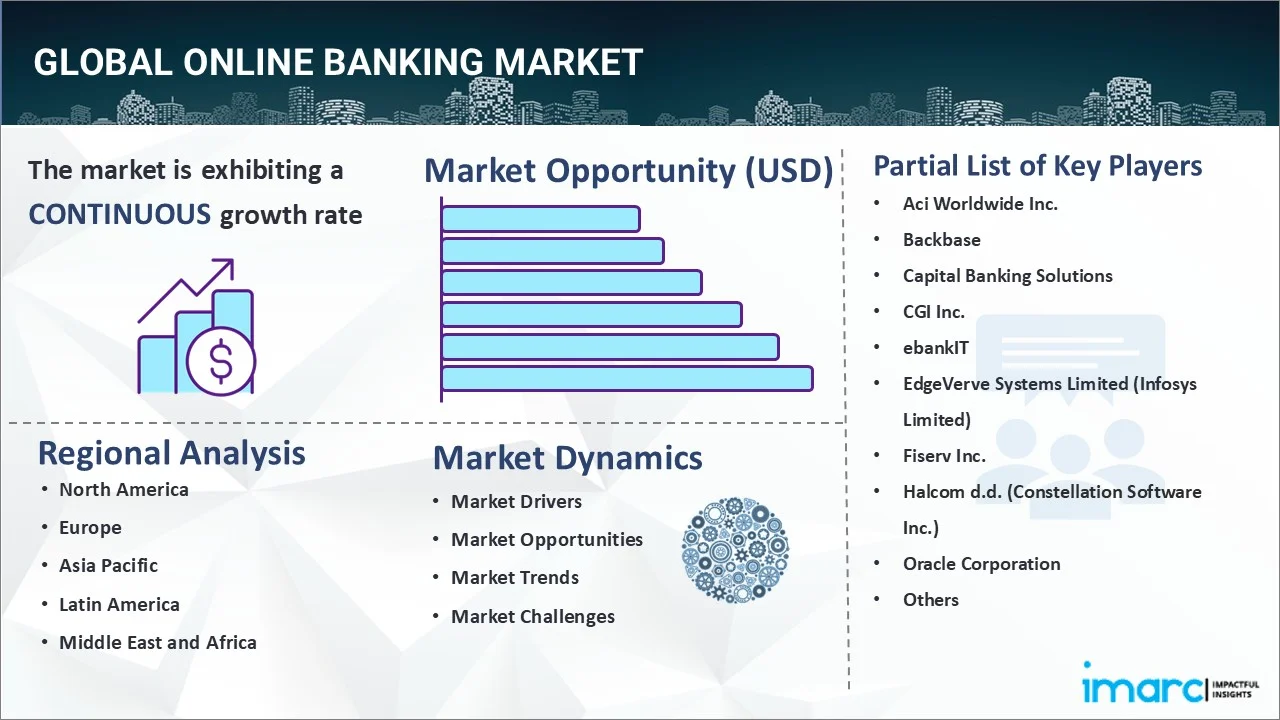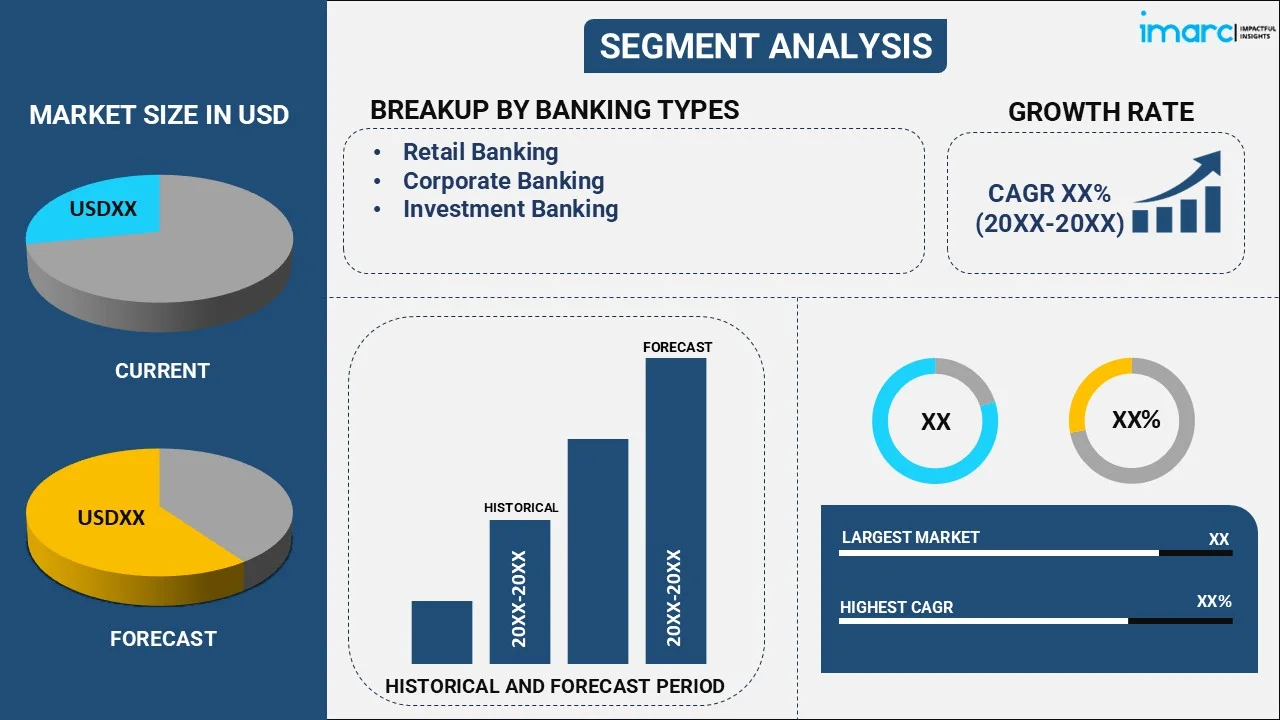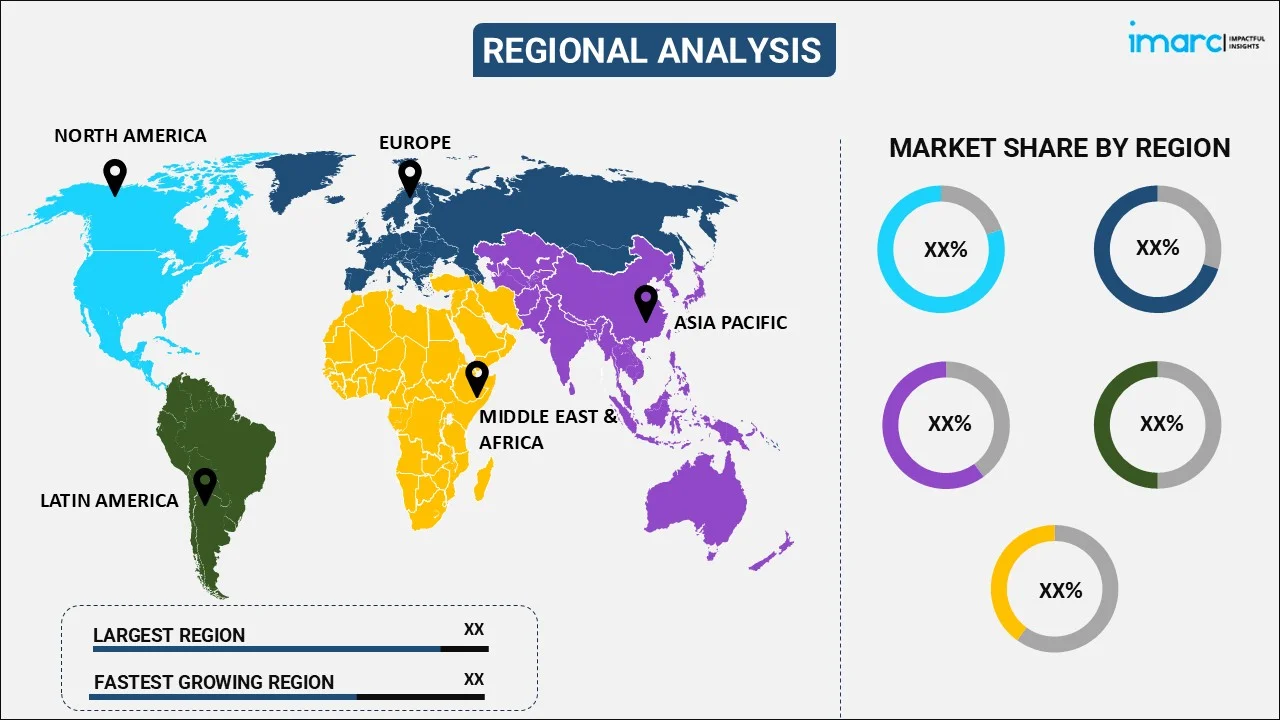
Online Banking Market Report by Banking Type (Retail Banking, Corporate Banking, Investment Banking), Software Type (Customized Software, Standard Software), Service Type (Payments, Processing Services, Customer and Channel Management, Wealth Management, and Others), and Region 2025-2033
Market Overview:
The global online banking market size reached USD 4.4 Billion in 2024. Looking forward, IMARC Group expects the market to reach USD 6.1 Billion by 2033, exhibiting a growth rate (CAGR) of 3.6% during 2025-2033. The growing usage of artificial intelligence (AI) and automation, rising preferences for contactless technologies, including virtual cards and touchless payment systems, and increasing implementation of robust security measures to safeguard client data and financial transactions are some of the factors impelling the market growth.
|
Report Attribute
|
Key Statistics
|
|---|---|
|
Base Year
|
2024
|
|
Forecast Years
|
2025-2033
|
|
Historical Years
|
2019-2024
|
|
Market Size in 2024
|
USD 4.4 Billion |
|
Market Forecast in 2033
|
USD 6.1 Billion |
| Market Growth Rate (2025-2033) | 3.6% |
Online banking, also known as internet banking, is an electronic payment system facility provided by banks and financial institutions. It allows customers to use banking services and conduct financial transactions over the internet. Some commonly offered services include online bill payments, account opening, deposits, and transfers. It also enables users to view account balances, check recent transactions, obtain statements, apply for credit cards, and order checks. In recent years, online banking has gained immense popularity across the globe due to its cost-effectiveness, ease of use, instant access, enhanced security, and fast service.

Online Banking Market Trends:
Enhanced Security Features
Security concerns often hinder the widespread adoption of online banking, as individuals are cautious about the safety of their financial information. However, advancements in cybersecurity are mitigating these fears. Banks are implementing robust measures, such as multifactor authentication, biometric security protocols, and real-time fraud detection systems, to safeguard client data and financial transactions. These innovations enhance the overall trustworthiness of online banking platforms, reassuring users about the safety of their digital interactions. Additionally, encryption technologies and artificial intelligence (AI) are strengthening the protection of sensitive information. The continuous evolution of these security mechanisms is making online banking a more reliable and secure option, leading to higher user confidence. In 2024, Airtel Payments Bank introduced two new security options, Fraud Alarm and Transparent Banking, within the Airtel Thanks application. These characteristics improve safety by enabling users to report questionable behavior and enhance transparency by consolidating essential account information in an easy-to-use layout. The initiative aims to make digital banking more secure and transparent for users.
Integration of Artificial Intelligence (AI) and Automation
Artificial intelligence (AI) and automation are revolutionizing the online banking experience by enhancing efficiency, personalization, and service quality. AI-driven systems enable banks to provide real-time user support, analyze large volumes of data, and predict client needs with high accuracy. Machine learning (ML) algorithms play a crucial role in identifying patterns in user behavior, enabling financial institutions to offer tailored services and personalized financial advice. Furthermore, automation is streamlining critical banking processes, such as account opening, loan approvals, and transaction monitoring, reducing the need for manual intervention and minimizing human error. These technologies are not only accelerating the speed of transactions but are also enhancing overall operational efficiency. In 2023, Temenos launched a secure Generative AI solution for banks, which enabled the automatic classification of client transactions to enhance personalization and user experiences. This solution integrated with Temenos' digital banking platform, providing accurate transaction insights while ensuring privacy and security. Temenos focused on ethical AI deployment as part of its ongoing innovation in banking.
Rise of Contactless Banking Solutions
Contactless technologies, including virtual cards and touchless payment systems, are becoming integral to online banking, enabling users to conduct transactions without the need for physical interaction. This shift is also extending to automated teller machine (ATM) usage and in-store purchases, where seamless integration of digital banking platforms with contactless payment methods is becoming the norm. Additionally, the rise of tokenization and encrypted payment methods is enhancing security and increasing user confidence in contactless solutions. The ongoing preference for contactless transactions is reshaping the banking landscape, as it aligns with user expectations for both convenience and safety. In 2023, ToneTag launched the Contextual Unified Secure Payment (CUSP) network, which supported digital payments like unified payments interface (UPI) and contactless tokenized cards. CUSP enhanced payment security with offline data transfer and voice-based payments. It also integrated the internet of things (IoT) devices for proximity detection and offered multiple payment options.
Key Market Segmentation:
IMARC Group provides an analysis of the key trends in each sub-segment of the global online banking market report, along with forecasts at the global, regional and country level from 2025-2033. Our report has categorized the market based on banking type, software type and service type.
Breakup by Banking Type:

- Retail Banking
- Corporate Banking
- Investment Banking
Breakup by Software Type:
- Customized Software
- Standard Software
Breakup by Service Type:
- Payments
- Processing Services
- Customer and Channel Management
- Wealth Management
- Others
Breakup by Region:

- North America
- United States
- Canada
- Asia-Pacific
- China
- Japan
- India
- South Korea
- Australia
- Indonesia
- Others
- Europe
- Germany
- France
- United Kingdom
- Italy
- Spain
- Russia
- Others
- Latin America
- Brazil
- Mexico
- Others
- Middle East and Africa
Competitive Landscape:
The competitive landscape of the industry has also been examined along with the profiles of the key players being Aci Worldwide Inc., Backbase, Capital Banking Solutions, CGI Inc., ebankIT, EdgeVerve Systems Limited (Infosys Limited), Fiserv Inc., Halcom d.d. (Constellation Software Inc.), Oracle Corporation, Tata Consultancy Services Limited, Technisys and Temenos AG.
Online Banking Market News:
- February 2024: Bandhan Bank partnered with Oracle to modernize its core banking system and expand digital services. Using Oracle FLEXCUBE and Oracle Banking Digital Experience, the bank enhanced operational efficiency, particularly in underserved areas, and improved services, such as loans and payments.
- May 2024: Temenos introduced its Responsible Generative AI solutions for core banking, enhancing efficiency and product management. These AI-powered solutions integrate with Temenos Core and Financial Crime Mitigation systems, offering transparency, explainability, and compliance for banks.
Report Coverage:
| Report Features | Details |
|---|---|
| Base Year of the Analysis | 2024 |
| Historical Period | 2019-2024 |
| Forecast Period | 2025-2033 |
| Units | Billion USD |
| Segment Coverage | Banking Type, Software Type, Service Type, Region |
| Region Covered | Asia Pacific, Europe, North America, Latin America, Middle East and Africa |
| Countries Covered | United States, Canada, Germany, France, United Kingdom, Italy, Spain, Russia, China, Japan, India, South Korea, Australia, Indonesia, Brazil, Mexico |
| Companies Covered | Aci Worldwide Inc., Backbase, Capital Banking Solutions, CGI Inc., ebankIT, EdgeVerve Systems Limited (Infosys Limited), Fiserv Inc., Halcom d.d. (Constellation Software Inc.), Oracle Corporation, Tata Consultancy Services Limited, Technisys and Temenos AG |
| Customization Scope | 10% Free Customization |
| Post-Sale Analyst Support | 10-12 Weeks |
| Delivery Format | PDF and Excel through Email (We can also provide the editable version of the report in PPT/Word format on special request) |
Key Questions Answered in This Report
The global online banking market was valued at USD 4.4 Billion in 2024.
The online banking market is expected to grow at a CAGR of 3.6% during 2025-2033, as per the IMARC Group. The expanding corporate banking sector is anticipated to drive the market in the coming years. Moreover, the emergence of the Banking as a Service (BaaS) business model is also expected to fuel the market growth over the forecasted period. Besides this, the escalating popularity of cashless transactions and the elevating presence of e-commerce companies across countries are expected to augment the online banking market in the coming years.
The major trends that can be witnessed in the online banking market include the rising internet penetration rate, the increasing digitization, and growing smartphone usage levels. Furthermore, the escalating number of real-time payment start-ups and the convenience, simplicity, and accessibility offered by these digital solutions are also acting as a significant growth-inducing factor. Apart from this, numerous key players are offering customized services and intuitive user interfaces for their websites and applications, which are propelling the market growth. Moreover, the growing integration of online banking solutions with chatbots, cloud computing, application programming interfaces (APIs), machine learning (ML), blockchain, robotic process automation (RPA), etc., is further bolstering the online banking market.
The sudden outbreak of the COVID-19 pandemic has led to the growing prominence of online banking solutions to avoid the risk of coronavirus infection upon human interaction across brick-and-mortar financial centers.
Based on the banking type, the global online banking market has been segmented into retail banking, corporate banking, and investment banking. Currently, retail banking holds the majority of the total market share.
Based on the service type, the global online banking market can be divided into payments, processing services, customer and channel management, wealth management, and others. Among these, payments exhibit a clear dominance in the market.
On a regional level, the market has been classified into North America, Asia-Pacific, Europe, Latin America, and Middle East and Africa, where North America currently dominates the global market.
Some of the major players in the global online banking market include Aci Worldwide Inc., Backbase, Capital Banking Solutions, CGI Inc., ebankIT, EdgeVerve Systems Limited (Infosys Limited), Fiserv Inc., Halcom d.d. (Constellation Software Inc.), Oracle Corporation, Tata Consultancy Services Limited, Technisys, and Temenos AG.
Need more help?
- Speak to our experienced analysts for insights on the current market scenarios.
- Include additional segments and countries to customize the report as per your requirement.
- Gain an unparalleled competitive advantage in your domain by understanding how to utilize the report and positively impacting your operations and revenue.
- For further assistance, please connect with our analysts.
 Inquire Before Buying
Inquire Before Buying
 Speak to an Analyst
Speak to an Analyst
 Request Brochure
Request Brochure
 Request Customization
Request Customization




.webp)




.webp)












